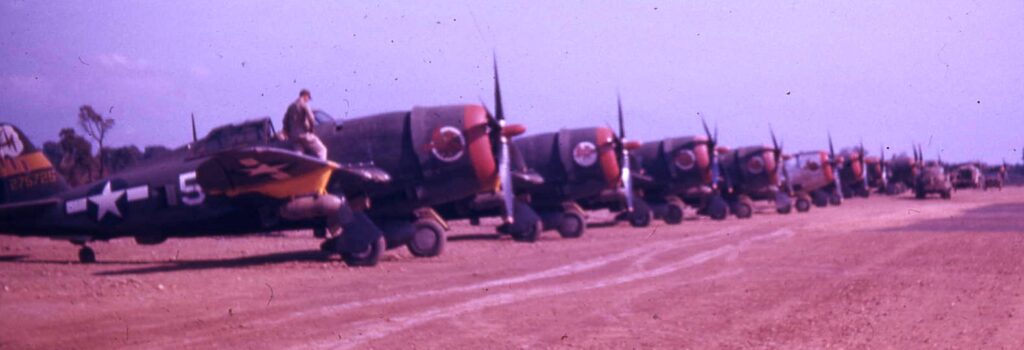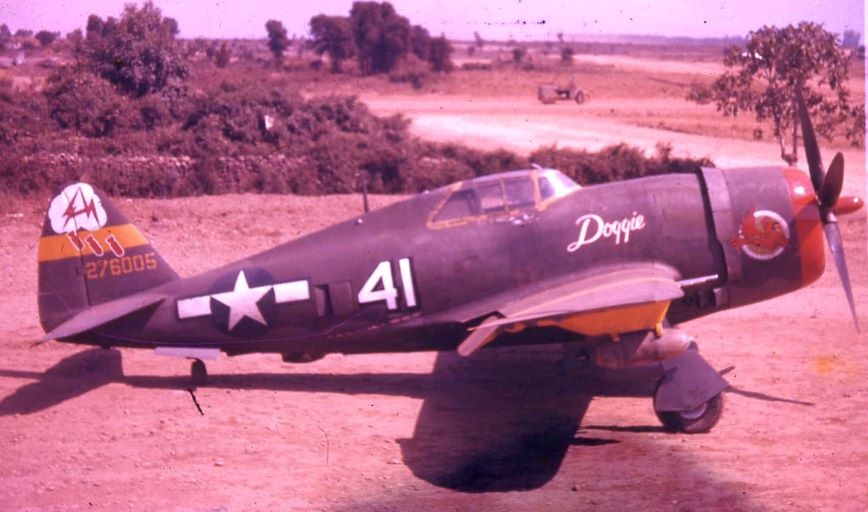P-47 Thunderbolt, Miomo
It had been 18 months since my last dive, and I fumbled clumsily whilst preparing my gear. I was sitting with two other divers in the spring sunshine, beside the picturesque little harbour at Erbalunga, Corsica. Our dive operator Rym, who took the task of conducting our refresher dive seriously, asked us questions about equipment and protocols as we fitted our kit together. Soon we were leaving the harbour in his fibreglass hull inflatable for a nearby spot, and rolling backwards out of the boat into the clear, chilly water. It felt good to be back diving, and whilst sitting on the sea floor, Rym took us through some of the basic exercises we had learned back in our qualification courses. It was a great way to blow out the cobwebs after a break from diving.
Next day I was back at Erbalunga, this time feeling more confident as I prepared my equipment. The water temperature may have been 16 degrees, but one of the distinct benefits of diving in Corsica in spring is there are no crowds, and today it was just Rym and I. Once again we motored out of the tiny harbour, but this time we headed south. Our short boat trip to the waters off the village of Miomo would take us to the site of one of Corsica’s World War II aviation mysteries – a United States Army Air Force (USAAF) P-47 Thunderbolt about which very little is known.
Corsica was a substantial USAAF base during the War, with 17 active airstrips1 and over 50,000 personnel2 stationed on the island.


Mishaps and air combat lead to many Allied and Axis aircraft crashing either on, or in the offshore waters off, Corsica.
Pilot J.M. Eubanks’ P-47, Corsica (source as above)
The P-47 we were to dive on that day was certainly one of them, but who was the pilot, and how did it come to be lying in 20 metres of water just off the village of Miomo?
Rym idled the boat, and whilst peering over the side, told me that sometimes the aircraft could be seen from the surface. Not so this day, and it took a little manoeuvring before he heaved the anchor overboard. I asked Rym if he knew whether the pilot had survived the crash. He told me there were two stories: one that the pilot had indeed survived (a conclusion also suggested by a couple of websites which cited the open cockpit as evidence of his escape4,5), and another that the pilot’s body had been recovered by residents of a neighbouring village. Wishing the former to be true, I secured my BCD (‘Buoyancy Control Device’) in preparation to roll out of the boat.
Descending down the anchor line, it took a few metres before the Thunderbolt came into view. I first recognised the aircraft’s huge silver coloured alloy nose, the rest of the plane being camouflaged by a coating of marine growth. A few more metres and the rest of the P-47 materialised.
After reaching the bottom, we slowly explored the wreck, careful not to touch the historic aircraft. Not only did we not wish to damage it, but we were conscious the place may also be a war grave.
The Thunderbolt’s enormous engine was missing from the fuselage, and at first I thought it may have been recovered. However it was lying a few metres from the aircraft, encrusted with sea life, presumably having broken free during impact.
Hovering above the aircraft, I watched as brightly coloured fish darted in and out of the cockpit. The pilot’s seat and pedals could be clearly seen, and although the cockpit hatch was indeed open, this alone is not evidence of the pilot’s survival. Although the airman may have opened the hatch prior, or post, the ditching, he may still not have survived the ordeal.
Salvagers, or perhaps souvenir hunters, had removed the P-47’s eight wing mounted machine guns.
After spending time exploring the wreck, I caught Rym’s attention and hugged myself, signalling that I was feeling the cold. We returned to the anchor rope and began the ascent back to the surface.
Seeing historic relics in situ, such as Miomo’s Thunderbolt, raises the question of the best way to preserve historic artefacts. One school of thought argues that relics should be removed from where they are found, and preserved in perpetuity within museums or other conservation facilities. Another believes that by taking an artefact from its environment, the link between the item and its historic setting is broken. The artefact is thus ‘devalued’ through a loss of geographic context. I belong in the second camp, although believe a balance can be struck.
If many examples of a particular object are already held within museum collections, thereby ensuring their long-term survival and enabling people to see, learn about, and enjoy them, then perhaps others can be left where they are found. This of course risks the eventual disappearance of the artefact due to natural environmental processes, or damage caused by disrespectful or ignorant visitors. However, seeing Miomo’s Thunderbolt lying on the Corsican sea bed, in the exact location where the drama unfolded over 75 years ago, was a profound experience, which I would not have felt so intently had I observed the recovered wreck in a museum.
As we headed back towards Erbalunga’s tiny harbour, I wondered if the mystery of Miomo’s Thunderbolt would ever be solved. Perhaps the pilot escaped the incident, returning to duty amongst the thousands of US servicemen based on Corsica, with no surviving record connecting him to his ditched P-47. Or maybe his body was recovered and identified some distance from the wreck, but the whereabouts of his aircraft was unknown. Or perhaps he lies somewhere beneath the waves, his name still listed amongst the ‘missing’.
Diving Miomo’s Thunderbolt was amazing, and I had soon planned my next dive on another of Corsica’s World War II ghosts: a USAAF B-17 Flying Fortress lying off the coastal city of Calvi in north-west Corsica…
1Abandoned, Forgotten and Little Known Airfields in Europe, 2018, ‘USS Corsica‘
2Tagliabue, J., 2008, ‘Corsica remembers Americans of World War II‘, The New York Times
3‘Photographs by James C. “Wabbit” Hare‘, Official Web-Site of the 57th Fighter Group
4Beckett, J., 2012, ‘Remains of a P-47 in France‘, War History Online
5Corse Images Sous-Marines, ‘Les épaves d’avions de la seconde guerre mondiale en cors‘
If you liked this post, you may also enjoy Diving the SS Thistlegorm, The Saint Didier
Do you have a particular interest in World War I, II and the Cold War? Check out my other blog Ghosts of War. If you enjoy military history, and want to know what it’s like to visit both significant and lesser-known wartime locations today, there’s something there for you.
Leave a Reply